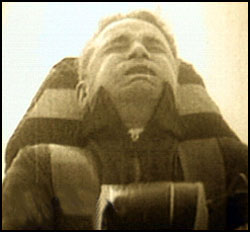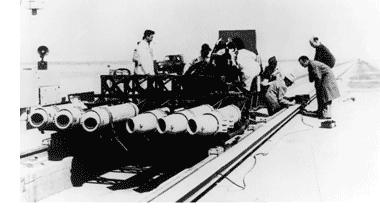Stapp, John Paul (1910–1999)

John Stapp on board the sled Sonic Wind.

Stapp during extreme acceleration.

The rocket motors of Sonic Wind.
John Stapp was an American pioneer of aerospace medicine, famous for his extreme rocket-sled experiments. Born in Bahia, Brazil, 1910, he was the son of Southern Baptist missionaries. Aged 12 he moved back to the States and later started college in Texas with the idea of becoming a writer. During Christmas vacation 1928 Stapp witnessed a tragedy that changed his life. While visiting relatives, his baby cousin crawled into a fireplace and was badly burned. For three days before it died, he helped nurse the child and afterward determined to become a doctor. Fifteen years later, having earned degrees in zoology and biophysics, he entered the University of Minnesota medical school to pursue his dream. When he graduated, he interned at St. Mary's hospital, Duluth, before enlisting in the Army Medical Corps during World War II.
In 1946, Stapp joined the aeromedical laboratory at Wright Field and served as flight surgeon to Chuck Yeager when he broke the sound barrier. Stapp became convinced that a significant pattern lay behind the way some airmen died and others survived seemingly equally violent crashes. To solve the mystery, he used a high-speed sled at Muroc Air Force Base (later known as Edwards AFB).
Gee Whiz
Stapp planned a series of tests on humans and set out to develop a harness to hold them safely to the rocket-powered sled, known as the Gee Whiz. First, he used a dummy named "Oscar Eight-Ball" to perfect the harness. Finally, after 32 sled runs, he was ready to try it out on a human guinea pig – himself. He was strapped into the sled facing rearward, refusing anesthetic because he wanted to study his reactions firsthand. Accelerated almost instantly to 90 mph, Stapp was then crushed against the seat back as the sled ground to an abrupt halt. He suffered only a few sore muscles. Within a year, Stapp had made sled runs at up to 150 mph, stopping in as little as 19 feet. He experienced up to 35 times the force of gravity (35g) and proved the human body could withstand such stress, although in the process he suffered headaches, concussions, a fractured rib and wrist, and a hemorrhaged retina.
When Stapp's commanding officer learned he'd been his own test subject, he ordered the experiments to stop, fearing he'd miss out on promotion if Stapp were killed. However, Stapp secretly continued the tests using chimpanzees and found that when strapped in correctly they survived forces many times those experienced in most plane crashes. From this, he concluded that crash survival doesn't depend on a body's ability to withstand the high forces involved, but rather on its ability to withstand the mangling effects of the vehicle. To back up this idea, Stapp again unofficially began tests on humans – putting himself first in the firing line. Over the next four years, he lost fillings, cracked more ribs, and broke his wrist again. Yet, despite these daredevil exploits, Stapp was known as a quiet, philosophical man who loved classical music. He refused to marry until his test days were over.
Murphy's law
In 1949, Stapp was involved in the birth of Murphy's law. Stapp's harness held 16 sensors to measure the g-force on different parts of the body. There were exactly two ways each sensor could be installed and it fell upon a certain Captain Murphy to make the connections. Before a run in which Stapp was badly shaken up, Murphy managed to wire up each sensor the wrong way, with the result that when Stapp staggered off the rocket sled with bloodshot eyes and bleeding sores, all the sensors read zero. Known for his razor-sharp wit, Stapp quipped: "If there are two or more ways to do something and one of those results in a catastrophe, then someone will do it that way."
Sonic Wind No.1
The advent of supersonic flight and the need to bail out at very high speed demanded more extreme experiments. Transferred to head the aeromedical field lab at Holloman Air Force Base, NM, Stapp built a much faster sled, called Sonic Wind No.l. Again, he began his studies using dummies but in March 1954 put himself forward as the subject. In his first ride on the new sled, Stapp reached 421 mph – a new land speed record.
On 10 December, he took the sled chair for his final and most extreme ride. His wrists were tied together in front of him, because flapping limbs would be torn away in the ferocious air stream. His major concern was that the rapid deceleration might blind him. Earlier he'd "practiced dressing and undressing with the lights out so if I was blinded I wouldn't be helpless." At the end of the countdown, Stapp was shot to 623 mph in 5 seconds and back to rest in just over a second. Subjected to 40-g, he temporarily blacked out and his eyeballs bulged from their sockets. Rushed to the hospital, his eyesight gradually returned, and a checkup revealed he'd suffered no major injury. An hour later, he was eating lunch.
Later he told the American Rocket Society that experiments with the rocket-powered sled would help pioneer the way to an early fulfillment of human space flight. He subsequently helped run tests on human and animal subjects in the giant Johnsville Centrifuge – the nightmare machine in which the early Mercury astronauts trained. In 1958, he married Lillian Lanese, who had danced with the Ballet Russe de Monte Carlo.
Automotive safety
Because of his expertise in safety at high speed, the Air Force loaned Stapp to the National Highway Traffic Safety Administration in 1967 as a medical scientist. Upon retirement with the rank of colonel in 1970, he became a professor in the University of California's Safety and Systems Management Center and, later, a consultant to the Surgeon General and to NASA. As chairman of the Stapp Foundation, he led the annual Stapp Car Crash Conference, which brought together automotive engineers, trauma surgeons and other experts to study how people died in car crashes. These conferences continue today.
The stapp
The stapp is a unit of exposure to acceleration or deceleration used in aerospace medicine and named after John Stapp. One stapp is the force exerted by one g acting on the human body for one second. Thus, an astronaut subjected to 3g for 12 seconds is said to have endured 36 stapps.

